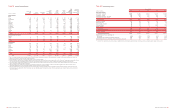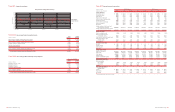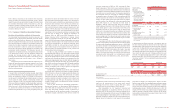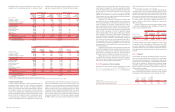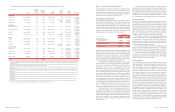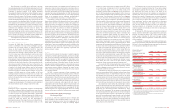Bank of America 2003 Annual Report Download - page 42
Download and view the complete annual report
Please find page 42 of the 2003 Bank of America annual report below. You can navigate through the pages in the report by either clicking on the pages listed below, or by using the keyword search tool below to find specific information within the annual report.
SFAS No. 133, “Accounting for Derivative Instruments and
Hedging Activities,” (SFAS 133) as amended by SFAS No. 137,
“Accounting for Derivative Instruments and Hedging Activities –
Deferral of Effective Date of Financial Accounting Standards Board
Statement No. 133,” and SFAS No. 138, “Accounting for Certain
Derivative Instruments and Certain Hedging Activities – an amend-
ment of FASB Statement No. 133,” also subsequently amended by
SFAS 149, was adopted by the Corporation on January 1, 2001. The
impact of adopting SFAS 133 to net income was a loss of $52 mil-
lion (net of related income tax benefits of $31 million) and a net tran-
sition gain of $9 million (net of related income taxes of $5 million)
included in other comprehensive income on January 1, 2001.
Cash and Cash Equivalents
Cash on hand, cash items in the process of collection, and amounts
due from correspondent banks and the Federal Reserve Bank are
included in cash and cash equivalents.
Securities Purchased under Agreements to Resell and
Securities Sold under Agreements to Repurchase
Securities purchased under agreements to resell and securities sold
under agreements to repurchase are treated as collateralized financ-
ing transactions and are recorded at the amounts at which the secu-
rities were acquired or sold plus accrued interest. The Corporation’s
policy is to obtain the use of securities purchased under agreements
to resell. The market value of the underlying securities, which collat-
eralize the related receivable on agreements to resell, is monitored,
including accrued interest. Additional collateral is requested when
deemed appropriate.
Collateral
The Corporation has accepted collateral that it is permitted by con-
tract or custom to sell or repledge. At December 31, 2003, the fair
value of this collateral was approximately $86.9 billion of which
$62.8 billion was sold or repledged. At December 31, 2002, the fair
value of this collateral was approximately $47.9 billion of which
$29.9 billion was sold or repledged. The primary source of this col-
lateral is reverse repurchase agreements. The Corporation pledges
securities as collateral in transactions that consist of repurchase
agreements, public and trust deposits, Treasury tax and loan notes,
and other short-term borrowings. This collateral can be sold or
repledged by the counterparties to the transactions.
In addition, the Corporation obtains collateral in connection with
its derivative activities. Required collateral levels vary depending on
the credit risk rating and the type of counterparty. Generally, the
Corporation accepts collateral in the form of cash, U.S. Treasury
securities and other marketable securities.
Trading Instruments
Financial instruments utilized in trading activities are stated at fair
value. Fair value is generally based on quoted market prices. If
quoted market prices are not available, fair values are estimated
based on dealer quotes, pricing models or quoted prices for instru-
ments with similar characteristics. Realized and unrealized gains and
losses are recognized in trading account profits.
Derivatives and Hedging Activities
All derivatives are recognized on the Consolidated Balance Sheet at
fair value, taking into consideration the effects of legally enforceable
master netting agreements which allow the Corporation to settle pos-
itive and negative positions with the same counterparty on a net
basis. For exchange-traded contracts, fair value is based on quoted
market prices. For non-exchange traded contracts, fair value is based
on dealer quotes, pricing models or quoted prices for instruments with
similar characteristics. The Corporation designates a derivative as
held for trading or hedging purposes when it enters into a derivative
contract. Derivatives designated as held for trading activities are
included in the Corporation’s trading portfolio with changes in fair
value reflected in trading account profits. Some credit derivatives used
by the Corporation do not qualify for hedge accounting under SFAS
133 and despite being effective economic hedges, changes in the fair
value of these derivatives are included in trading account profits.
The Corporation formally documents at inception all relationships
between hedging instruments and hedged items, as well as its risk
management objectives and strategies for undertaking various hedge
transactions as required by SFAS 133. Additionally, the Corporation
uses regression analysis at the hedge’s inception and quarterly there-
after to assess whether the derivative used in its hedging transaction
is expected to be or has been highly effective in offsetting changes in
the fair value or cash flows of the hedged items. The Corporation dis-
continues hedge accounting when it is determined that a derivative is
not expected to be or has ceased to be highly effective as a hedge, and
then reflects changes in fair value in earnings.
The Corporation uses its derivatives designated for hedging
activities as either fair value hedges, cash flow hedges or hedges of
net investments in foreign operations. The Corporation manages
interest rate and foreign currency exchange rate sensitivity predomi-
nantly through the use of derivatives. Fair value hedges are used to
limit the Corporation’s exposure to changes in the fair value of its
fixed interest-earning assets or interest-bearing liabilities that are
due to interest rate or foreign exchange volatility. Cash flow hedges
are used to minimize the variability in cash flows of interest-bearing
assets or liabilities or anticipated transactions caused by interest
rate or foreign exchange fluctuation. Changes in the fair value of
derivatives designated for hedging activities that are highly effective
as hedges are recorded in earnings or other comprehensive income,
depending on whether the hedging relationship satisfies the criteria
for a fair value or cash flow hedge, respectively. Hedge ineffective-
ness and gains and losses on the excluded component of a deriva-
tive in assessing hedge effectiveness are recorded in earnings. SFAS
133 retains certain concepts under SFAS No. 52, “Foreign Currency
Translation,” (SFAS 52) for foreign currency exchange hedging.
Consistent with SFAS 52, the Corporation records changes in the fair
value of derivatives used as hedges of the net investment in foreign
operations as a component of other comprehensive income.
The Corporation from time to time purchases or issues financial
instruments containing embedded derivatives. The embedded derivative
is separated from the host contract and carried at fair value if the eco-
nomic characteristics of the derivative are not clearly and closely related
to the economic characteristics of the host contract. To the extent that
the Corporation cannot reliably identify and measure the embedded
derivative, the entire contract is carried at fair value on the Consolidated
Balance Sheet with changes in fair value reflected in earnings.
If a derivative instrument in a fair value hedge is terminated or
the hedge designation removed, the difference between a hedged
item’s then carrying amount and its face amount is recognized into
income over the original hedge period. Similarly, if a derivative instru-
ment in a cash flow hedge is terminated or the hedge designation
removed, related amounts accumulated in other comprehensive
income are reclassified into earnings over the original hedge period
during which the hedged item affects income.
Securities
Debt securities are classified based on management’s intention on
the date of purchase and recorded on the Consolidated Balance
Sheet as of the trade date. Debt securities, which management has
the intent and ability to hold to maturity, are classified as held-to-
maturity and reported at amortized cost. Securities that are bought
and held principally for the purpose of resale in the near term are
classified as trading instruments and are stated at fair value with
unrealized gains and losses included in trading account profits. All
other debt securities are classified as available-for-sale and carried
at fair value with net unrealized gains and losses included in share-
holders’ equity on an after-tax basis.
Interest on debt securities, including amortization of premiums
and accretion of discounts, are included in interest income. Realized
gains and losses from the sales of securities are determined using
the specific identification method.
Marketable equity securities, which are included in other
assets, are carried at fair value. Net unrealized gains and losses are
included in shareholders’ equity, on an after-tax basis; income is
included in noninterest income. Venture capital investments for which
there are active market quotes are carried at estimated fair value,
subject to liquidity discounts, sales restrictions or regulatory rules.
Net unrealized gains and losses are recorded in noninterest income.
Venture capital investments for which there are not active market
quotes are initially valued at cost. Subsequently, these investments
are adjusted to reflect changes in valuation as a result of initial pub-
lic offerings or other-than-temporary declines in value.
Loans and Leases
Loans are reported at their outstanding principal balances net of any
unearned income, charge-offs, unamortized deferred fees and costs
on originated loans, and premiums or discounts on purchased loans.
Loan origination fees and certain direct origination costs are deferred
and recognized as adjustments to income over the lives of the related
loans. Unearned income, discounts and premiums are amortized to
income using methods that approximate the interest method.
The Corporation provides equipment financing to its customers
through a variety of lease arrangements. Direct financing leases are
carried at the aggregate of lease payments receivable plus estimated
residual value of the leased property, less unearned income.
Leveraged leases, which are a form of financing lease, are carried net
of nonrecourse debt. Unearned income on leveraged and direct
financing leases is amortized over the lease terms by methods that
approximate the interest method.
Allowance for Credit Losses
The allowance for credit losses which includes the allowance for loan
and lease losses and the reserve for unfunded lending commitments,
represents management’s estimate of probable losses inherent in
our lending activities. The allowance for loan and lease losses repre-
sents our estimated probable losses in our funded commercial and
consumer loans and leases while our reserve for unfunded lending
commitments, including standby letters of credit and binding
unfunded loan commitments, represents estimated probable losses
in these off-balance sheet credit instruments. Credit exposures,
excluding derivative assets and trading account assets, deemed to
be uncollectible are charged against these accounts. Cash recovered
on previously charged off amounts are credited to these accounts.
The Corporation performs periodic and systematic detailed
reviews of its lending portfolios to identify credit risks and to assess
the overall collectibility of those portfolios. The allowance on certain
homogeneous loan portfolios, which generally consist of consumer
loans, is based on aggregated portfolio segment evaluations gener-
ally by product type. Loss forecast models are utilized for these seg-
ments which consider a variety of factors including, but not limited to,
historical loss experience, estimated defaults or foreclosures based
on portfolio trends, delinquencies, economic conditions and credit
scores. The remaining portfolios are reviewed on an individual loan
basis. Loans subject to individual reviews are analyzed and segre-
gated by risk according to the Corporation’s internal risk rating scale.
These risk classifications, in conjunction with an analysis of histori-
cal loss experience, current economic conditions and performance
trends within specific portfolio segments, and any other pertinent
information (including individual valuations on nonperforming loans in
accordance with SFAS No. 114, “Accounting by Creditors for
Impairment of a Loan,” (SFAS 114)) result in the estimation of the
allowance for credit losses.
If necessary, a specific allowance for loan and lease losses is
established for individual impaired commercial loans. A loan is con-
sidered impaired when, based on current information and events, it
is probable that the Corporation will be unable to collect all amounts
due, including principal and interest, according to the contractual
terms of the agreement. Once a loan has been identified as individ-
ually impaired, management measures impairment in accordance
with SFAS 114. Individually impaired loans are measured based on
the present value of payments expected to be received, observable
market prices, or for loans that are solely dependent on the collateral
for repayment, the estimated fair value of the collateral. If the
recorded investment in impaired loans exceeds the measure of esti-
mated fair value, a specific allowance is established as a component
of the allowance for loan and lease losses.
Components of the allowance for loan and lease losses are
allocated to cover the estimated probable losses in each loan and
lease category based on the results of the Corporation’s detail review
process described above. The specific component continues to be
weighted toward the commercial loan portfolio, which reflects a
higher level of nonperforming loans and the potential for higher indi-
vidual losses. The formula component of the allocated allowance cov-
ers performing commercial loans and leases, and consumer loans.
The remaining or general component of the allowance for loan and
lease losses, determined separately from the procedures outlined
80 BANK OF AMERICA 2003 BANK OF AMERICA 2003 81




